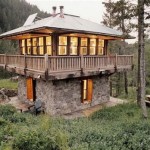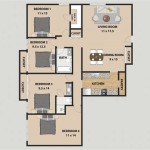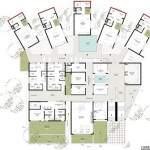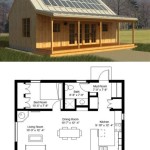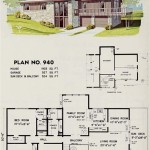Small One Bedroom House Floor Plans: Maximizing Space and Functionality
Small one-bedroom houses are becoming increasingly popular due to factors such as affordability, environmental consciousness, and a shift towards minimalist living. Designing an effective floor plan for a small one-bedroom space requires careful consideration of space optimization, functionality, and personal needs. The goal is to create a comfortable and livable environment within a limited footprint.
This article will explore key elements and strategies involved in designing successful small one-bedroom house floor plans, focusing on maximizing space, enhancing functionality, and creating a welcoming and efficient living environment. Understanding the principles of spatial planning and considering various design options is crucial for achieving a successful outcome.
Prioritizing Open Concept Design
One of the most effective strategies for making a small one-bedroom house feel larger is to embrace an open concept design. This typically involves combining the living area, dining area, and kitchen into a single, unified space. Removing walls between these areas creates a sense of spaciousness and allows for better flow of natural light. The absence of physical barriers also facilitates social interaction and creates a more inviting atmosphere.
To further enhance the feeling of openness, consider using consistent flooring throughout the combined living space. This visual continuity creates a seamless transition between areas and helps to visually expand the room. Light-colored walls and ceilings also contribute to a brighter and more airy feel. Choosing furniture with a low profile can prevent the space from feeling cluttered or cramped. Modular furniture offers flexibility and can be easily reconfigured to suit different needs.
While an open concept design is beneficial, it is also important to define distinct zones within the shared space. This can be achieved through the strategic placement of furniture, such as a sofa acting as a divider between the living area and the dining area. Rugs can also be used to delineate different zones. For example, a rug placed under the dining table can visually separate it from the living area. The use of different lighting fixtures is another effective way to define spaces. Pendant lights can be used to highlight the dining area, while recessed lighting can be used in the living area to create a more relaxed ambiance.
Optimizing Storage Solutions
Storage is paramount in a small one-bedroom house. Maximizing storage space can significantly improve the functionality and livability of the home. Utilizing vertical space is a key strategy. Installing shelves that reach the ceiling can provide ample storage without taking up valuable floor space. These shelves can be used to store books, decorative items, and other belongings.
Built-in storage solutions are also highly effective. Consider incorporating built-in cabinets, drawers, and shelves into the walls. This can be particularly useful in the bedroom, where built-in closets can provide ample storage for clothing and accessories. In the kitchen, built-in cabinets and pantries can help to keep the space organized and clutter-free. The use of multi-functional furniture is another way to optimize storage. A bed with built-in drawers underneath can provide extra storage space for bedding, clothing, or other items. A coffee table with a lift-top can be used to store books, magazines, or remote controls.
Underutilized spaces, such as the area under the stairs or the space above doorways, can also be repurposed for storage. Custom-built shelving or cabinets can be installed in these areas to create additional storage space. In the bathroom, consider using a wall-mounted vanity to free up floor space. A medicine cabinet with a mirror can provide storage for toiletries and other bathroom essentials. The key is to think creatively and identify opportunities to maximize storage in every area of the house.
Designing a Functional Kitchen and Bathroom
The kitchen and bathroom are two of the most important rooms in any house, regardless of size. In a small one-bedroom house, it is crucial to design these rooms efficiently to maximize functionality and convenience.
In the kitchen, consider using a compact layout, such as a galley kitchen or a U-shaped kitchen. These layouts are designed to minimize the amount of walking required to access different areas of the kitchen. Installing appliances that are smaller in size, such as a compact refrigerator or a combination microwave oven, can also save valuable space. Vertical storage solutions, such as pot racks and spice racks, can help to keep the countertop clear and organized. A pull-out cutting board can provide extra workspace when needed and can be easily tucked away when not in use. Good lighting is essential in the kitchen. Install under-cabinet lighting to illuminate the countertop and make it easier to prepare food. Consider using a light-colored backsplash to reflect light and make the kitchen feel brighter.
In the bathroom, a well-designed layout can make a small space feel much larger. Consider using a wall-mounted toilet to free up floor space. A walk-in shower can also save space compared to a traditional bathtub. Install a large mirror above the vanity to reflect light and create a sense of spaciousness. The use of light-colored tiles can also make the bathroom feel brighter and more airy. Incorporate storage solutions, such as a medicine cabinet and a wall-mounted shelf, to keep the countertop clear and organized. Good ventilation is essential in the bathroom to prevent moisture buildup. Install a powerful exhaust fan to remove moisture and prevent mold and mildew growth.
Creating a Comfortable and Functional Bedroom
The bedroom is the sanctuary in any home, and its design should prioritize comfort and relaxation. In a small one-bedroom house, careful planning is required to maximize space and create a functional and inviting bedroom.
The bed is the focal point of the bedroom, so it's important to choose a bed that is appropriately sized for the room. A platform bed with built-in storage can provide extra storage space without taking up additional floor space. Alternatively, a bed frame with space underneath can be used to store items in storage bins. Maximize closet space by using organizers, such as shelving units, drawers, and hanging rods. Consider installing a full-length mirror on the closet door to save space and provide a convenient place to get dressed. Nightstands can be used to store bedside essentials, such as books, lamps, and alarm clocks. Choose nightstands that are compact in size to avoid taking up too much space. A dresser can be used to store clothing and other items. Consider using a vertical dresser to maximize storage space without taking up too much floor space. Good lighting is essential in the bedroom. Install bedside lamps to provide reading light and create a relaxing ambiance. Consider using blackout curtains to block out light and ensure a good night's sleep.
Consider the placement of furniture carefully to maximize space and create a comfortable flow. Avoid overcrowding the room with too much furniture. Instead, focus on essential pieces that are both functional and stylish. Use light colors on the walls and bedding to make the room feel brighter and more airy. Incorporate personal touches, such as artwork, photographs, and decorative items, to make the bedroom feel cozy and inviting. A well-designed bedroom should be a relaxing and comfortable space where one can retreat and recharge.
Incorporating Natural Light and Ventilation
Natural light and ventilation are crucial for creating a healthy and comfortable living environment in any home, especially in a small one-bedroom house. Maximizing natural light can make a small space feel larger and more inviting, while good ventilation can improve air quality and prevent moisture buildup.
Windows are the primary source of natural light. Maximize the amount of natural light entering the house by using large windows. Consider installing skylights or light tubes to bring natural light into areas that don't have direct access to windows. Avoid blocking windows with furniture or heavy curtains. Use sheer curtains or blinds to filter light and provide privacy. Light-colored walls and ceilings can reflect light and make the space feel brighter. Mirrors can also be used to reflect light and create a sense of spaciousness. Position mirrors strategically to reflect light from windows and other light sources.
Good ventilation is essential for maintaining air quality and preventing moisture buildup. Ensure that the house has adequate ventilation by opening windows regularly. Install exhaust fans in the kitchen and bathroom to remove moisture and odors. Consider using a whole-house fan to circulate air and reduce energy consumption. Proper insulation can also help to maintain a consistent temperature and prevent drafts. A well-ventilated and well-lit house is a healthier and more comfortable place to live.
Selecting Appropriate Furniture and Decor
The selection of furniture and decor plays a significant role in the overall look and feel of a small one-bedroom house. Choosing the right pieces can maximize space, enhance functionality, and create a cohesive and stylish living environment.
Opt for furniture that is appropriately sized for the space. Avoid oversized pieces that will overwhelm the room and make it feel cramped. Choose furniture that is multi-functional. A sofa bed can provide extra sleeping space for guests, while a coffee table with storage can help to keep the living area organized. Consider using modular furniture. This allows for flexibility and can be easily reconfigured to suit different needs. Choose furniture that is lightweight and easy to move. This makes it easier to rearrange the furniture and create different layouts. Use light colors on walls, furniture, and flooring to make the space feel brighter and more airy. Incorporate pops of color through accessories, such as pillows, throws, and artwork. This can add personality and visual interest to the space.
Avoid cluttering the space with too many decorative items. Choose a few key pieces that reflect your personal style and create a cohesive look. Consider using vertical space for decorative items. Hang artwork on the walls and use shelves to display books and decorative objects. The use of mirrors can create an illusion of spaciousness. Place mirrors strategically to reflect light and create a sense of depth. A well-chosen selection of furniture and decor can transform a small one-bedroom house into a stylish and comfortable home.

Ranch Style House Plan 1 Beds Baths 896 Sq Ft 771 One Bedroom Plans

1 Bedroom House Plan Examples

Small 1 Bedroom House Plan Plans Tiny Floor Guest

International House 1 Bedroom Floor Plan Top View One Plans

3 Reasons To Build A 1 Bedroom House Plan

1 Bedroom House Plan Examples

1 Bedroom Tiny House 30sqm Design Basic Floor Plan With Elevation Sections Digital

Best One Story House Plans And Ranch Style Designs

Small House Design With Floor Plan 1 Bedroom

Low Cost Cottage House Plans Vacation And Cabin




